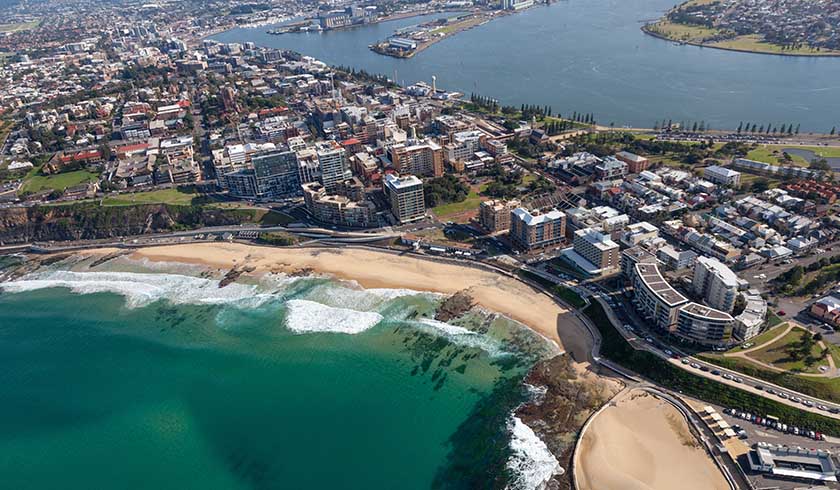8 areas to watch on the NSW northern coast
According to new research, NSW North Coast regions will continue to outperform capital cities in 2022.

The Market Pressure Review Report by InvestorKit looked at a number of NSW North Coast regions, including Coffs Harbour, Gosford, Lake Macquarie - East, Newcastle, Port Macquarie, Port Stephens, Richmond Valley - Coastal, and Wyong.
The report studied market pressure indicators between June 2020 and August 2021 “to demonstrate the changes in sales and rental prices and stock levels, speed of sales and other changes”.
Market pressure indicators can highlight the areas that will give investors the most bang for their buck. When market pressure is high, there is positive growth for short-term capital and rental price. Market pressure indicators pertain to median price, sale days on the market, monthly listings, monthly sale volume, vendor discounting, vacancy rates, rents, and yields.
InvestorKit’s founder and head of research, Arjun Paliwal, remarked that “property market pressure for the NSW northern coastal markets is currently some of the highest in the country”.
Regional data shows that total monthly listings are falling, and there was a significant drop in the number of days a property has been on the market. An alarmingly low vacancy rate of 1 per cent is also common, while monthly sales volumes in all eight regions continue to rise.
Implications for the NSW North Coast property market
For investors, this bears good news but presents challenges for those new at trying to break into the market who must expect a highly competitive environment.
Rental data on the NSW North Coast reflects similar intense market pressures as the sales market. Currently at crisis levels, a surge in rental pricing and demand among those renting can be expected. A 4 per cent gross rental yield near Sydney’s major hubs will surely be attractive to investors.
Here’s the low-down on what to expect from the 8 areas to watch in the NSW North Coast:
1. Gosford
The median house price in Gosford has been slowly increasing, according to data from September 2020, whilst monthly sales volumes have been increasing since June 2021, even though there was a decrease in the number of new house listings. Despite the number of listings falling in the last year, rentals continue to see a high demand.
|
Median House Price:
Loading form...
|
18.4% increase over the last 12 months |
|
Monthly Sales Volumes: |
reached a peak of 310 homes in July 2021 and continues to grow since June 2021 |
|
Average Days on Market: |
down -34.4% over the last 12 months |
|
Vendor Discounting: |
down -12.7% over the past 12 months |
|
Monthly Rental Listings: |
down -28.7% over the past year |
|
Rental Yield: |
3.0% |
|
Vacancy Rate: |
<1.0% |
2. Wyong
Wyong’s median house price increased in the last year, and the average number of days on the market has decreased. Notable in the Wyong SA3 region is the rental crisis, with vacancy rates as low as 0.3 per cent. Due to market pressure, Wyong's median rents increased in early 2021.
|
Median House Price: |
16.7% increase over the last 12 months |
|
Monthly Sales Volumes: |
reached a peak of 306 homes in July 2021 and continues to grow since June 2021 |
|
Average Days on Market: |
down -40.2% over the last 12 months |
|
Vendor Discounting: |
down -9.7% over the past 12 months |
|
Monthly Rental Listings: |
down -34.5% over the past year |
|
Rental Yield: |
3.5% |
|
Vacancy Rate: |
0.3% |
3. Lake Macquarie - East
The median price in Lake Macquarie - East has been steadily rising since the second quarter of 2020, whilst the average number of days on the market has been decreasing. Increased demand and decline in number of listings further intensifies market pressure in the region.
|
Median House Price: |
13.7% increase over the last 12 months |
|
Monthly Sales Volumes: |
reached a peak of 194 homes in June 2021 and has been growing since late 2020 |
|
Average Days on Market: |
down -31.3% over the last 12 months |
|
Vendor Discounting: |
down -8.2% over the past 12 months |
|
Monthly Rental Listings: |
down -29.0% over the past year |
|
Rental Yield: |
3.0% |
|
Vacancy Rate: |
0.5% |
4. Newcastle
Newcastle is contributing to the high-pressure market in NSW with a median property price increase of 15.3 per cent over the last 12 months. Investors can expect a good rental yield as monthly rental listings in the region continue to decline.
|
Median House Price: |
15.3% increase over the last 12 months |
|
Monthly Sales Volumes: |
reached a peak of 266 homes in July 2021 and has been growing since July 2020 |
|
Average Days on Market: |
down -33.8% over the last 12 months |
|
Vendor Discounting: |
down -14.1% over the past 12 months |
|
Monthly Rental Listings: |
down -21.0% over the past year |
|
Rental Yield: |
3.5% |
|
Vacancy Rate: |
1.0% |
5. Port Stephens
Port Stephens has the largest decrease in monthly rental listings among the eight NSW North Coast areas with a -40.6% decline over the past year. It also has the second to lowest median house price increase next to Port Macquarie.
|
Median House Price: |
10.7% increase over the last 12 months |
|
Monthly Sales Volumes: |
reached a peak of 130 homes in July 2021 and has been growing since July 2020 |
|
Average Days on Market: |
down -29.8% over the last 12 months |
|
Vendor Discounting: |
down -17.5% over the past 12 months |
|
Monthly Rental Listings: |
down -40.6% over the past year |
|
Rental Yield: |
3.5% |
|
Vacancy Rate: |
0.5% |
6. Port Macquarie
Among the eight regions in the North Coast, Port Macquarie had the lowest median price increase at 10.2 per cent. Despite this, investors can still expect a good rental yield of at least 4 per cent. Monthly rental listings are also on a downward trend since June 2020.
|
Median House Price: |
10.2% increase over the last 12 months |
|
Monthly Sales Volumes: |
reached a peak of 155 homes in June 2021 and has been growing since September 2020 |
|
Average Days on Market: |
down -19.6% over the last 12 months |
|
Vendor Discounting: |
down -17.8% over the past 12 months |
|
Monthly Rental Listings: |
down -35.3% over the past year |
|
Rental Yield: |
4.0% |
|
Vacancy Rate: |
<1.0% |
7. Coffs Harbour
Coffs Harbour has seen one of the highest median price increases in the country, whilst its rental market is under pressure due to falling rental listings. This makes Coffs Harbour an appealing investment location since most coastal areas don’t have such high rental yields of up to 4 per cent.
|
Median House Price: |
21.0% increase over the last 12 months |
|
Monthly Sales Volumes: |
reached a peak of 138 homes in July 2021 and has been growing since mid-2020 |
|
Average Days on Market: |
down -18.9% over the last 12 months |
|
Vendor Discounting: |
down -19.0% over the past 12 months |
|
Monthly Rental Listings: |
down -31.8% over the past year |
|
Rental Yield: |
4.0% |
|
Vacancy Rate: |
<1.0% |
8. Richmond Valley - Coastal
The report shows that the highest median price increase was recorded in Richmond Valley - Coastal or the SA3 region. This location covers Ballina, Brunswick Heads, Byron, Bangalow, Woodburn, Evans Head, and surrounding areas. Monthly sales volume continues to increase as new listing percentages fall, contributing to increased market pressure. This scenario is the same for the rental market as listings continue to decline over the past year.
|
Median House Price: |
27.3% increase over the last 12 months |
|
Monthly Sales Volumes: |
reached a peak of 123 homes in July 2021 and has been growing since mid-2020 |
|
Average Days on Market: |
down -32.5% over the last 12 months |
|
Vendor Discounting: |
down -11.9% over the past 12 months |
|
Monthly Rental Listings: |
down -37.1% over the past year |
|
Rental Yield: |
3.5% |
|
Vacancy Rate: |
1.0% |
In summary, the report states that rents and prices will “continue their momentum into the first half of 2022, pending no large external forces step into the equation”.
These exciting developments in the NSW North Coast regions contribute to the prediction that it will be more profitable than Australia’s capital cities.
Mr Paliwal concluded by explaining that the red-hot property market will become hotter due to intense market pressure influenced by:
- Low cash rates
- Greater access to credit and owner-occupier financing
- Localized job market strengths and recovery
- Government spending/stimulus
- Higher household savings ratios
- Flexibility of working from home
- Years of low investor activity reducing supply
- Changing lifestyle preferences
The full Market Pressure Review Report can be found here.
